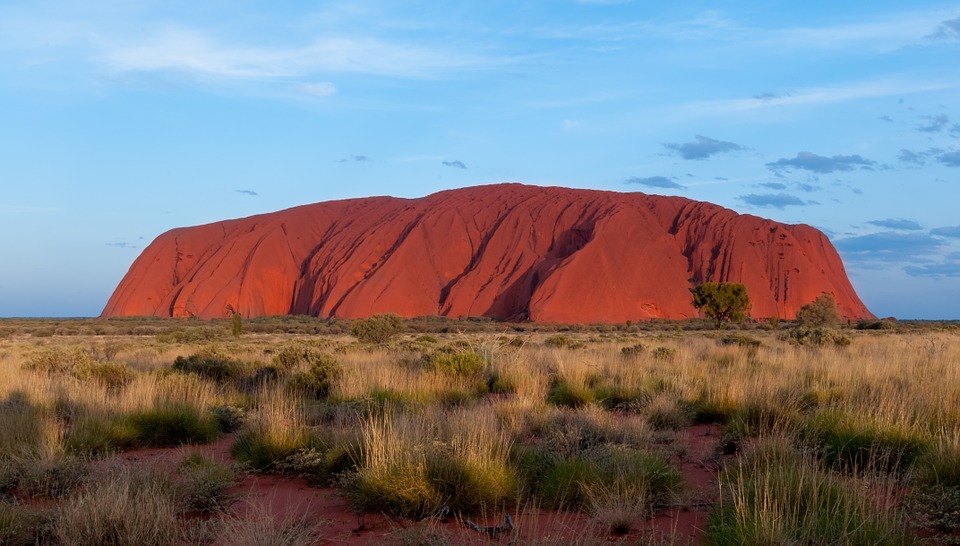World's Largest Rock
A friend of mine mention one day about the world’s largest rock. A few days later I could not remember where he said, so I decided to look it up. There seems to be a little big of controversy as to which rock is the largest, but it seems that everyone agrees it comes down to only 2 rocks, both of them being in Australia. Read some of the things below and judge for yourself.
—-
In Central Australia, at the eastern edge of the Gibson Desert, there is a sandstone horst, Ayers Rock, appreciated to be “the world’s largest rock”, rising 348 m (1,142 ft) over the desert plateau (its maximum height is of 863 m (2,831 ft)), with a circumference of 9.4 km (5.8 mi). This is what erosion left from an ancient mountain. It has many springs, waterholes, rock caves and ancient paintings, being listed as a World Heritage Site for its natural and man-made attributes. Also called Uluru, the rock is sacred to the Pitjantjatjara and Yankunytjatjara, the Aboriginal people of the area.
Mount Olga, located 25 km to the west, is a group of such smaller monoliths, which occupy a surface of 21.7 square km. At the highest point, Mount Olga is 1066 m above sea level, or approximately 546 m above the surrounding plain. It is composed of conglomerate, a sedimentary rock consisting of cobbles and boulders of varying rock types including granite and basalt, cemented by a matrix of sandstone.
All these rocks offer in the sunlight special visual effects and change color as the different light strikes them at different of times the day and year, glowing red on the sunset. During wet periods the Ayers Rock acquires a silvery-grey color, with streaks of black algae forming on the areas that serve as channels for water flow. They are located at 335 km (208 mi) west of Alice Springs, the closest city.
In this area there’s a typical vegetation made of desert oak (Acacia coriacea), ironwood (Casuarina equisetifolia), bloodwood (Corymbia opaca), Spinifex grass, while the fauna is represented by kangaroos, wallabies, dingo, emu and many other marsupials.
http://news.softpedia.com/news/The-Largest-Stone-in-the-World-57451.shtml
Uluru in the heart of Australia is a striking rock monolith rising spectacularly from the desert plain. One of Australia’s most popular tourist attractions, it was better known as Ayers Rock until its Aboriginal name, Uluru, became more popular.
While Uluru and Alice Springs are often linked together, they are in fact more than 450 kilometres apart. Yet one hardly visits one without visiting the other.
Uluru is 348 metres high, 3.6 kilometres long, 1.9 kilometres wide, and is 9.4 kilometres around. It is the largest rock monolith in the world.
The world’s largest rock, also found in Australia, is Mt Augustus in the Golden Outback region of Western Australia. Mt Augustus is a monocline and not a rock monolith.
Visitors converge before sundown on the Uluru Sunset Viewing Area which provides a magnificent spectacle of the rock monolith as it shifts hues with the dying of the day, turning into brilliant red just before the sun vanishes and plunges the desert into night. There is an Uluru Sunrise Viewing Area on the other side of Uluru.
http://goaustralia.about.com/cs/ntsightseeing/a/uluru.htm
—-
Mount Augustus, or Burringurrah, is twice the size of Australia’s more famous outback icon, rising 715m out of the parched plains of the Gascoyne region, 850km north of Perth.
Burringurrah is an environmental treasure steeped in Dreamtime mythology but one that remains little known to most Australians.
Unlike Uluru, which is a monolith (a single block of stone) and was exposed as the surrounding landscape weathered away over millions of years, Burringurrah is a monocline – a fold in the rock layers – and was pushed up as the earth buckled about 900 million years ago. Only about one-third of the rock is said to be visible, the rest remaining below the surface.
To get to Burringurrah, it’s a long journey over wide red-dirt outback roads with bulldust-fi lled pot-holes and sandy-bed river crossings.
Along the way, the baked earth is littered with flat stones the size of a clenched fist that glow reddish and dark purple in the soft morning light but can shimmer into the distance like a black lake in the harsh afternoon sun. Native grasses struggle for survival but flocks of galahs defy the unforgiving terrain.
It doesn’t rain very often, but when it does road access can be cut for months at a time.
The area around Mount Augustus is the traditional lands of the Wajarri tribe who named the rock Burringurrah. (The last Wajarri tribesmen left the rock camp in the 1960s to work on the surrounding cattle stations and a new community was established nearby in the mid-’80s.)
http://www.theaustralian.com.au/news/features/journey-to-mount-augustus-the-worlds-biggest-rock/story-e6frg8h6-1226118449787
—-
Other Links on this subject
http://sabbah.biz/mt/archives/2005/03/08/uluru-ayers-rock-the-largest-rock-in-the-world/
http://en.wikipedia.org/wiki/List_of_largest_monoliths_in_the_world
http://www.trivia-library.com/b/world-tourist-sights-ayers-rock-australia.htm
http://www.touropia.com/largest-monoliths-in-the-world/ (10 largest in the world)


Hi! I am a robot. I just upvoted you! I found similar content that readers might be interested in:
http://news.softpedia.com/news/The-Largest-Stone-in-the-World-57451.shtml